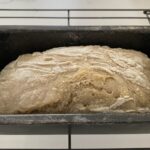If like me you make a batch of dough, or even two or three different types, to use just what you need every day, sometimes you will find the dough has relaxed too much to keep its shape. Don’t panic.
Using relaxed bread dough
If your dough is too relaxed to hold its shape, either because the dough is a bit too old or the dough was made with too much liquid, then this is the absolute simplest method. If you need to use the dough right now, it's too late to add more flour. Simple: put the bread into a bread pan and just let it rise for the usual length of time. Maybe the dough will be too loose to slash the surface – but go with it. The bread will bake – maybe not your best ever loaf – but hey, you've still got lunch.
Equipment
- loaf tin size to suit the dough you have leftover
Materials
- release spray, oil or butter
- flour for dusting
Instructions
- spray or grease the loaf tin
- pre-heat your oven to the usual temperature for your loaf, say 200ºC to 220ºC though higher is better.
- flour your work surface and empty the dough and form a ball, coated with a light dusting of flour. Press it into the correct length for the loaf tin.
- Bake for the usual time, or if using a higher temperature, reduce time by about 10 minutes.
- Empty out of the tin and allow to cool on a wire rack

Revive Sourdough Dough
This will get your dough ready for using the next day. If you need something faster then I would suggest a method using dried yeast.Far from being a rescue, this is actually a method used in many parts of the world: some of the dough is saved and then this is used to make dough for the next day. The sourdough continues to do its work and depending on temperature this dough could be ready to use within 4 or 5 hours, or more likely the next day.I mixed a batch like this and this less than half filled the plastic tub. At a cool kitchen temperature the dough totally filled the tub after a few hours.
Equipment
- Stand mixer with dough hook
Instructions
- Put the bowl of the mixer and zero. Add the older dough and check the weight. You can add new bread flour, water and salt to about the same weight.
- Add the flour and water in a proportion of 2 to 1. eg 400 g flour and 200 ml water and a tsp of salt
- Mix with the stand mixer for about 8 minutes, starting slowly for 2 minutes and then speed up
- Add a small amount of flour or water as required
- This will be ready to bake tomorrow
Poolish Bread
This will revive your dough ready for baking same morning.
Equipment
- Stand mixer with dough hook
Instructions
- Put the bowl of the mixer and zero. Add the older dough and check the weight. You can add new flour, water and salt to about the same weight.
- Add the flour and water in a proportion of 2 to 1. eg 400 g flour and 200 ml water and a tsp of salt, packet of yeast
- Mix with the stand mixer for about 8 minutes, starting slowly for 2 minutes and then speed up
- Add a tiny amount of flour or water as needed
- Allow to rise for an hour
- Empty the dough out from the bowl and shape as you would want to and allow to rise again



